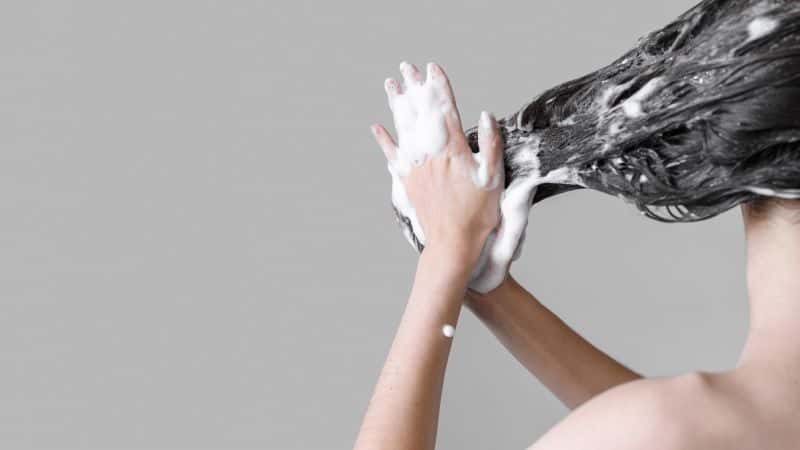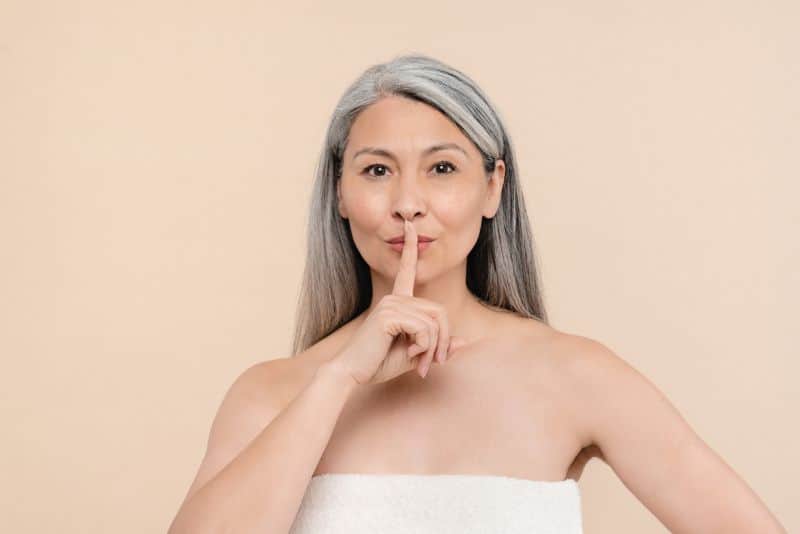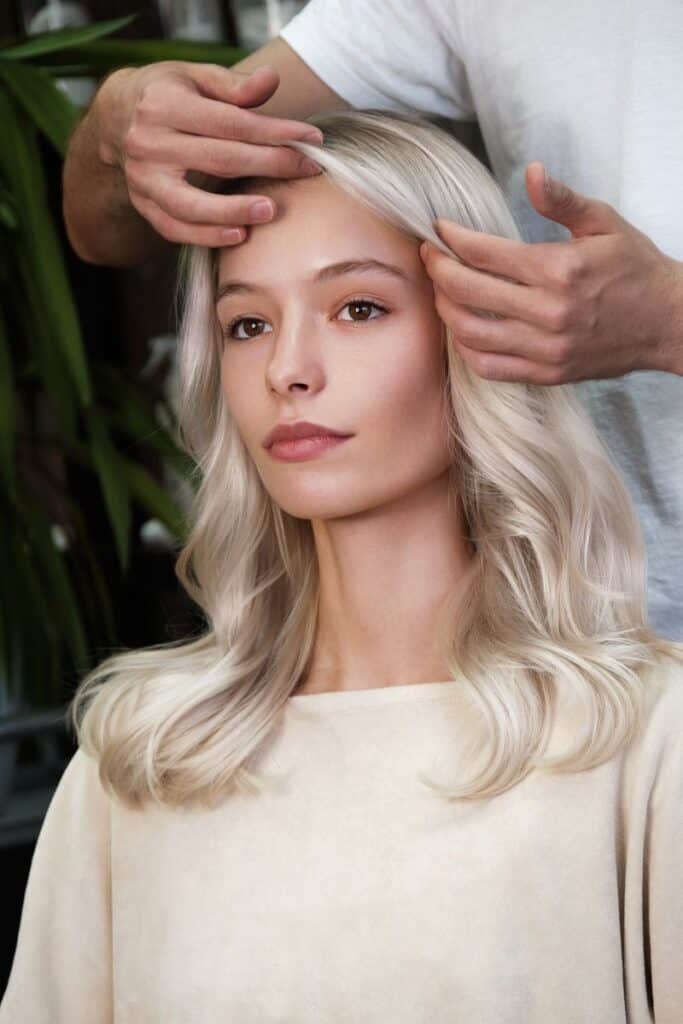Last Updated on December 29, 2022 by Gaga
Coloring your hair may seem like a straightforward process, but it can be challenging if your locks are not in optimal condition. While healthy hair is generally easy to dye, some types of hair can be very stubborn or unpredictable when it comes to taking hair color.
- Over-processed or damaged hair is highly porous and may process color too fast, resulting in a darker color than desired. Damaged areas such as dry ends suck up hair dye, which may lead to uneven coverage.
- Low porosity hair is resistant to absorbing chemical treatments, and processing time may take longer than with normal porosity hair.
- Coarse gray hair is more resistant to dyes, so you may find it difficult to get full coverage.

If your hair doesn’t absorb dye well, you must take some additional steps before color application to ensure that you will get the desired shade and even coverage. Some pre-color treatments are designed to remove all kinds of buildup to create an optimal base for color application. This helps to ensure that the color is deposited evenly and enhances vibrancy.
You must also protect your scalp and hair from chemical damage, especially if you color your hair regularly. The good news is that a variety of pre-color products are available to help you counteract the harmful effects of dye chemicals. Some pre-color treatments are also meant to protect your scalp from irritation and reduce chemical damage to the hair.
Types of Pre-Color Treatments
1. Hair Clarifying Treatments
Your hair shouldn’t be perfectly clean before coloring. Natural oils form a protective barrier that helps reduce scalp irritation and reduce chemical hair damage. However, if you have build-up from too many styling products, previous coloring, or environmental factors, you need to clarify your hair before coloring. Clarifying treatments performed two days before coloring ensure that the color will adhere better to your hair. Clarifying and chelating shampoos are commonly used to remove product and mineral buildup and allow color molecules to enter the hair shaft.
Many products are designed especially to prepare your hair for vibrant, long-lasting color. Malibu C Color Prepare and MADISON REED Prime for Perfection Hair Color Primer are some of the popular color primers. If you use these products, make sure to follow directions and apply them within recommended time before getting your hair colored.

2. Protective Pre-Color Treatments
These treatments are especially important for coloring processes that involve bleach. They help minimize damage during the coloring process and strengthen your hair. Pre-color serums massaged into the hair before coloring act as a barrier between harsh chemicals and the most fragile areas of your hair.
Some pre-color products (like Follicle Guard Pre-Color Treatment) are meant to be applied before the coloring process to coat the scalp and prevent chemicals from reaching hair follicles.
Coconut oil pre-color treatment is an efficient, affordable, and easy-to-apply pre-dye treatment. It is especially effective for high-porosity hair. This oil can penetrate the hair shaft and prevent hair damage. Make sure to apply coconut oil the night or at least several hours before you color to allow your hair to fully absorb it. Concentrate on the dryest and most porous area of your hair. Don’t rinse the oil before coloring.
3. Hair Porosity Equalizer
These pre-color treatments balance the hair’s porosity before the coloring or lightening process to ensure more even color distribution. Protein-rich pre-color treatments help reduce porosity and smooth dry, overly porous hair. Such hair will absorb color evenly from roots to ends. Colorful Neutral Protein Filler is a well-known porosity equalizer that protects hair from damage, repairs broken bonds, and ensures even color absorption.
Protein-based porosity equalizers are not suitable for low-porosity hair. Low-porosity hair needs to be treated with alkaline solutions or heat to temporarily lift the cuticle and prepare the hair to absorb dye.
4. Pre-Color Treatments for Gray Hair
Gray hair often resists coloring and may need more time to fully absorb the dye. Washing with a clarifying shampoo before coloring dissolves excess buildup and makes it easier for dye molecules to penetrate your hair.
Very stubborn gray hair must be pre-softened before coloring to achieve full coverage. You should apply a 20-volume hydrogen peroxide developer and let it sit in your hair for 5-10 minutes. The developer lifts the cuticle for better color penetration. Rinse out the developer and dry your hair before color application.

5. Hair Color Removers
Color strippers are designed to remove the color buildup from previous colorings or remove unwanted hair dye to create the optimal base for a new color application. If your hair has undergone many coloring sessions, this will make it easier to get the color you want.
What Hair Color Primer to Use for Your Hair?
Pre-color primers are versatile products that provide multiple benefits for hair dye addicts. Your stylist will select the optimal pre-color treatment based on the condition of your hair and the brand of hair color that you are going to use.
Most pre-color primers can be used at home. Some pre-color treatments work better when the heat is applied, while others don’t require any heat to be effective. Always make sure to read the instructions because application methods may differ for different products. Pre-color treatments that come in a spray bottle are the most convenient for users.
If you are planning to do the dying job yourself, you can’t be wrong with coconut oil. To get the most benefits, choose virgin coconut oil, which is made without chemicals.

Gaga is a blogger and founder of the Softer Hair website. She often says that insomnia is to blame for her first blogging attempts. Being the night owl, she hated the morning alarm. She left her office job and returned to what she loved most - writing.


Getting ready to use L’Oréal Excellence Creme, on my previously colored hair.
Directions are vague for the (PRE)Pre-Color Treatment.
Directions state…”Massage PRE into dry ends before coloring. Avoid root area. Do not rinse.
The PRE should not be applied to mid-length & ends if this is first time coloring”.
***I have short hair & applying to ends would be too difficult. My hair is color-treated.
**Do I put the PRE on all over…or…not at all?
Hydrogen peroxide is not ideal for pre-softening resistant grays because it is acidic; acidic solutions close the cuticle, not swell it. Cuticle swelling happens in alkaline states; you need something with a higher pH. You’ll get a better result by applying any liquid Hi-Lift color directly to the areas needing softening for 15 minutes. Wipe off the sections with a damp cotton or towel and apply the desired shade.